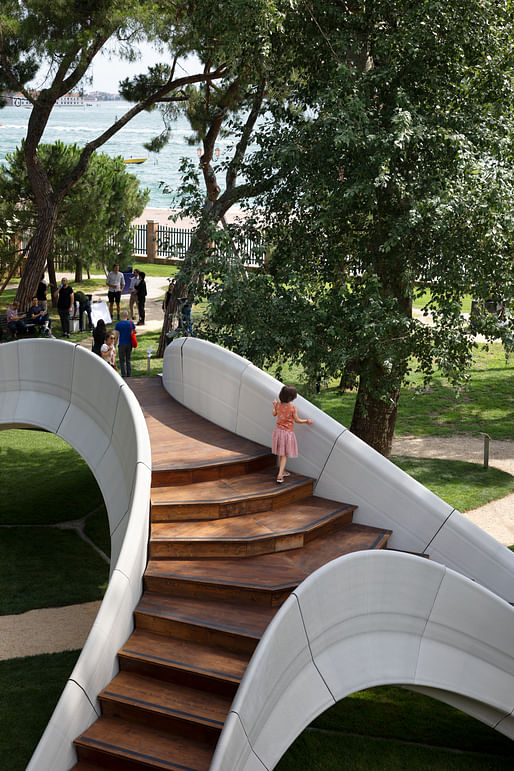
A first-of-its-kind arched masonry footbridge composed of 3D-printed concrete blocks and assembled without mortar or reinforcement is now open in Venice. The project, called Striatus, is being showcased at the public park Giardini della Marinaressa during the 2021 Venice Architecture Biennale until November.
The approximately 40-by-52-foot pedestrian bridge was developed through a collaboration between the Block Research Group (BRG) at ETH Zurich and Zaha Hadid Architects Computation and Design Group (ZHACODE), in collaboration with Incremental3D (in3D) and made possible by Holcim. The project combines traditional masonry techniques with advanced computational design, engineering, and robotic manufacturing technologies. It aims to demonstrate an alternative, more sustainable, and ecologically responsible approach to building with concrete.
Striatus is composed of a new type of 3D-printed concrete, which the researchers developed together with in3D. In total, 53 concrete blocks comprise the footbridge. Instead of being applied horizontally, the concrete was printed at specific angles, orthogonal to the flow of compressive forces. This kept the printed layers in the blocks pressed together, without the need for reinforcement or post-tensioning.
“This precise method of 3D concrete printing allows us to combine the principles of traditional vaulted construction with digital concrete fabrication to use material only where it is structurally necessary without producing waste,” said ETH professor Philippe Block.

This compression-only structure, thus, achieves its strength and stability through its geometry alone. It “allows the forces to travel to the footing, which are tied together on the ground,” as detailed by the design team. Using material only where needed, Striatus greatly reduces its environmental footprint. In addition, because it doesn’t require mortar, the blocks can be dismantled, relocated, and reassembled at a different location. And, if the footbridge reaches the end of its life, the materials can be easily separated and recycled.
“Striatus offers a blueprint for building more with less,” says the project team. Outside of just a footbridge, they envision this approach as an alternative to standard inefficient floor slabs within any building. They also claim that this new unreinforced floor system uses only 30% of the volume of concrete and just 10% of the amount of steel compared to traditional reinforced-concrete flat floor slabs.
“With an estimated 300 billion square meters of floor area to be constructed worldwide over the next 30 years,” says the team, “and floors comprising more than 40% of the weight of most high-rise buildings (10+ stories), introducing the principles demonstrated by Striatus would truly disrupt the construction industry — transforming how we design and construct our built environment to address the defining challenges of our era.”
No Comments
Block this user
Are you sure you want to block this user and hide all related comments throughout the site?
Archinect
This is your first comment on Archinect. Your comment will be visible once approved.